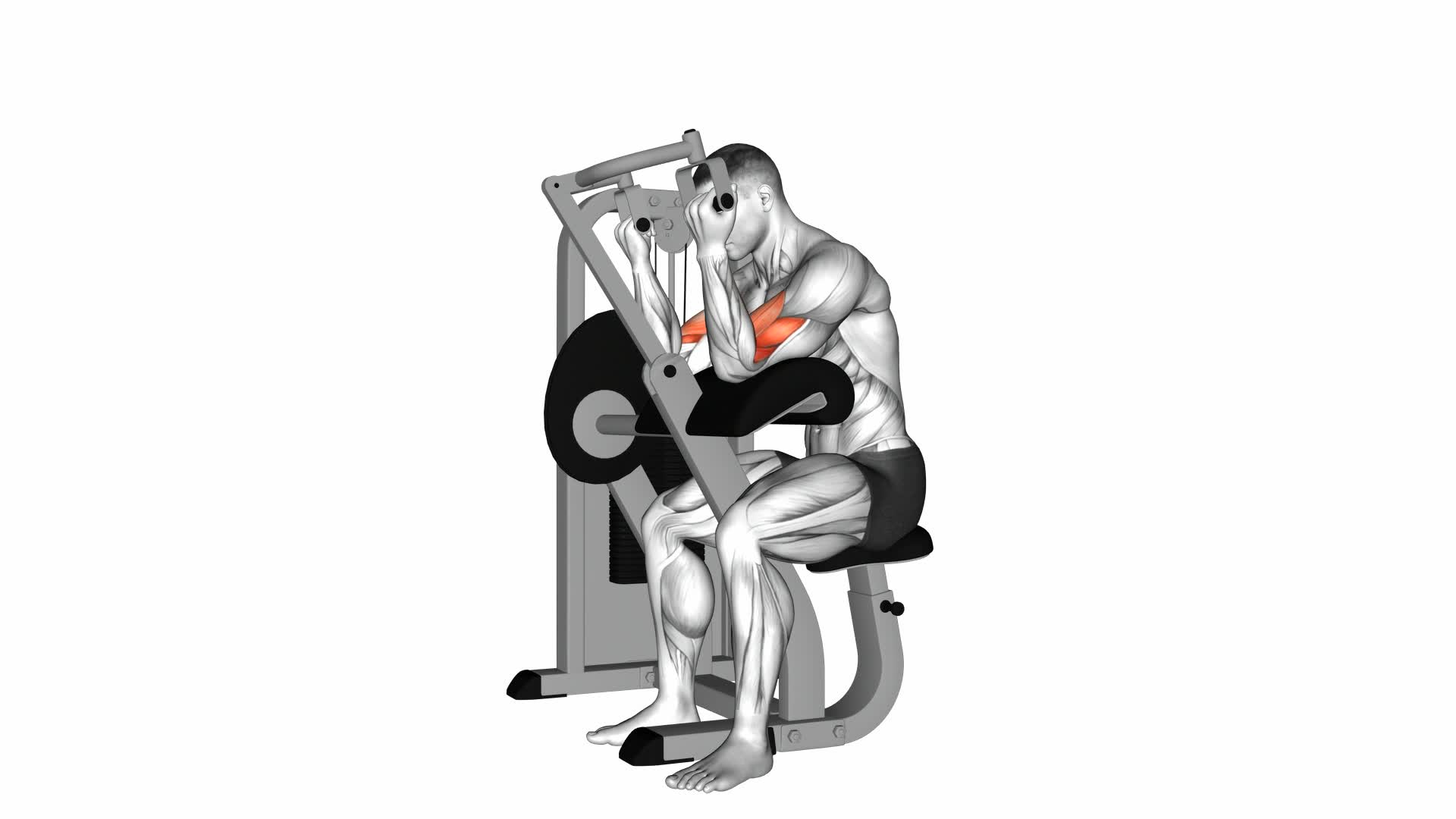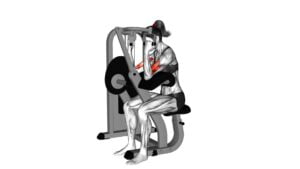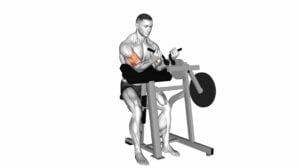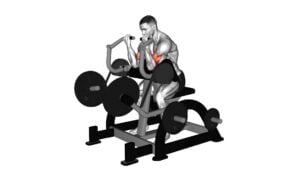Lever Preacher Curl (version 2) – Video Exercise Guide & Tips

If you want to maximize your arm gains, the Lever Preacher Curl (version 2) is a must-try exercise.
Watch This Exercise Video
In this video exercise guide, we'll show you the proper form and technique for this variation, as well as variations and modifications to keep challenging your muscles.
Avoid common mistakes and learn tips for increasing intensity.
Get ready to pump up those biceps with this targeted workout.
Let's dive in!
Key Takeaways
- The Lever Preacher Curl (version 2) is an effective and efficient way to strengthen and sculpt biceps.
- It provides elbow stability and isolation, reducing strain and the risk of injury.
- The exercise offers excellent bicep isolation, maximizing muscle activation.
- Proper form and technique, such as maintaining stable elbow positioning and avoiding excessive wrist flexion, are crucial for performing the exercise correctly.
Benefits of the Lever Preacher Curl (version 2)
Get ready to experience the numerous benefits of the Lever Preacher Curl (version 2), as it provides you with an effective and efficient way to strengthen and sculpt your biceps. This exercise is specifically designed to target your biceps while providing excellent elbow stability and bicep isolation.
One of the key benefits of the Lever Preacher Curl (version 2) is its ability to enhance elbow stability. By resting your upper arms on the pad and gripping the handles, you're able to isolate the movement to your biceps without involving other muscles. This helps to reduce strain on your elbows, minimizing the risk of injury.
In addition to promoting elbow stability, the Lever Preacher Curl (version 2) also offers excellent bicep isolation. The unique design of the machine allows you to fully contract and stretch your biceps, ensuring maximum muscle activation. This targeted stimulation helps to increase muscle growth and definition in your biceps.
By incorporating the Lever Preacher Curl (version 2) into your workout routine, you can expect to see significant improvements in your bicep strength and size. Not only does it provide effective elbow stability and bicep isolation, but it also allows for precise and controlled movements, ensuring proper form and minimizing the risk of injury.
Proper Form and Technique for the Lever Preacher Curl (Version 2)
To perform the Lever Preacher Curl (Version 2) with proper form and technique, it's crucial to pay attention to your elbow positioning. Keep your elbows stable and close to the lever pad throughout the exercise to maximize engagement of the biceps muscles.
Additionally, avoid excessive wrist flexion by maintaining a neutral wrist position, which helps prevent strain and potential injury.
Elbow Positioning Importance
Maintain proper elbow positioning during the Lever Preacher Curl (Version 2) to optimize form and technique. Proper elbow alignment is crucial for effective muscle activation and to prevent strain or injury.
Follow these tips for optimal elbow positioning:
- Keep your elbows locked in place: Position your elbows firmly against the preacher pad throughout the exercise to maintain stability and avoid unnecessary movement.
- Avoid elbow flaring: Keep your elbows close to your body and avoid letting them flare out to the sides. This helps to target the biceps more effectively and reduces stress on the shoulders.
- Maintain a slight bend in the elbow: While performing the exercise, keep a small, constant bend in your elbow to ensure tension remains on the biceps throughout the movement.
- Control the eccentric phase: When lowering the weight, do so in a controlled manner, maintaining tension in the biceps and avoiding any sudden or jerky movements.
By maintaining proper elbow positioning, you can maximize the effectiveness of the Lever Preacher Curl (Version 2) and minimize the risk of injury.
Now, let's move on to the next section and learn about avoiding excessive wrist flexion.
Avoiding Excessive Wrist Flexion
Make sure you keep your wrists in line with your forearms to avoid excessive flexion during the Lever Preacher Curl (Version 2). Proper hand positioning is crucial to avoiding wrist strain and maintaining proper form during this exercise. When gripping the lever, make sure your palms are facing up and your wrists are straight. Avoid bending your wrists too far forward or backward, as this can put unnecessary strain on the joint. By keeping your wrists aligned with your forearms, you distribute the load more evenly and reduce the risk of injury.
Remember to engage your forearm muscles and focus on the contraction as you curl the lever towards your shoulders.
Now, let's move on to discussing variations and modifications for the Lever Preacher Curl (Version 2).
Variations and Modifications for the Lever Preacher Curl (Version 2)
Now let's explore some variations and modifications for the Lever Preacher Curl (Version 2).
By adjusting your grip width or using different equipment like dumbbells or resistance bands, you can target different muscle groups and add variety to your workout routine.
These modifications can help you challenge your muscles in new ways and prevent plateaus in your progress.
Proper Form Techniques
To ensure proper form while performing the Lever Preacher Curl (Version 2), it's important that you focus on using controlled movements and engaging your biceps throughout the exercise. Here are some key techniques to keep in mind:
- Elbow Positioning: Place your upper arms firmly against the pad of the preacher curl bench, ensuring that your elbows are slightly forward. This position helps isolate the biceps and prevents unnecessary strain on the joints.
- Wrist Flexion: As you curl the lever, concentrate on flexing your wrists and bringing your palms towards your shoulders. This movement maximizes bicep activation and helps maintain tension throughout the exercise.
- Controlled Eccentric Phase: Lower the lever slowly and under control, resisting the weight as it descends. This eccentric phase is crucial for muscle development and strength gains.
- Full Range of Motion: Aim to fully extend your arms at the bottom of the movement, and then curl the lever up until your biceps are fully contracted. This ensures that you're working the biceps through their complete range of motion.
Equipment Alternatives
To enhance your workout and target your biceps even more, consider exploring equipment alternatives for the Lever Preacher Curl (Version 2).
If you're a beginner or don't have access to a preacher curl bench, don't worry! There are modifications you can make to still perform this exercise effectively.
One alternative is to use a stability ball. Sit on the ball with your feet firmly planted on the ground, and perform the curl using dumbbells or a resistance band. This will engage your core muscles as well.
Another option is to use an adjustable bench set at a slight incline. Sit on the bench with your chest against the backrest, and perform the curl using dumbbells or a barbell.
These equipment alternatives provide a similar range of motion and target your biceps effectively, making them suitable for beginners or those without access to specific equipment.
Muscle Group Targeting
If you want to target different muscle groups while performing the Lever Preacher Curl (Version 2), there are variations and modifications you can incorporate into your workout routine. Here are some ways to enhance muscle group activation and maximize the benefits of isolation exercises:
- Narrow grip: By placing your hands closer together on the lever bar, you can focus more on your biceps and increase the intensity of the exercise.
- Wide grip: Conversely, a wider grip will shift the emphasis to your brachialis and brachioradialis muscles, helping to develop overall arm strength and size.
- Pronated grip: Changing your hand position to an overhand grip will engage your forearms more, providing a more comprehensive arm workout.
- Supinated grip: On the other hand, using an underhand grip will primarily target your biceps, isolating and strengthening this muscle group.
Common Mistakes to Avoid During the Lever Preacher Curl (Version 2)
Avoiding common mistakes during the Lever Preacher Curl (Version 2) is essential for maximizing your results. Proper elbow position and wrist alignment are crucial to perform this exercise correctly and avoid injury.
One common mistake is allowing your elbows to flare out to the sides during the movement. This not only reduces the effectiveness of the exercise but also puts unnecessary strain on your shoulder joints. To avoid this, keep your elbows close to your body and maintain a stable position throughout the entire range of motion.
Another mistake to avoid is improper wrist alignment. It's important to keep your wrists straight and in line with your forearms throughout the exercise. Avoid bending your wrists or allowing them to drop down, as this can strain the joint and increase the risk of injury. Focus on maintaining a neutral wrist position and keeping the tension on the targeted muscles.
Remember to start with a weight that allows you to maintain proper form and gradually increase the resistance as you become more comfortable and confident with the exercise. By avoiding these common mistakes and maintaining proper elbow position and wrist alignment, you can ensure an effective and safe Lever Preacher Curl (Version 2) workout that will help you achieve your desired results.
Tips for Increasing Intensity and Progress With the Lever Preacher Curl (Version 2)
To increase the intensity and progress with the Lever Preacher Curl (Version 2), focus on gradually increasing the weight you lift. Here are some tips to help you maximize your results:
- Increase weights: As you become comfortable with a certain weight, challenge yourself by adding more weight. This will stimulate muscle growth and increase overall strength.
- Controlled tempo: Pay attention to the tempo of your repetitions. Slow down the lowering phase (eccentric) and focus on contracting your biceps during the lifting phase (concentric). This controlled tempo increases muscle tension and promotes muscle growth.
- Progressive overload: Continuously strive to push yourself beyond your comfort zone. Increase the weight or perform more repetitions each week to progressively overload your muscles and stimulate further growth.
- Variations in tempo: Incorporate tempo variations into your training. Try performing slower repetitions for a set, followed by faster repetitions for another set. This variation challenges your muscles in different ways and helps prevent plateaus.
Sample Workout Routine Incorporating the Lever Preacher Curl (Version 2)
To incorporate the Lever Preacher Curl (Version 2) into your workout routine, focus on utilizing proper form and gradually increasing the weight you lift. This exercise targets your biceps and can be a great addition to your arm training.
When incorporating the Lever Preacher Curl (Version 2) into your workout routine, it's recommended to perform it 2-3 times per week. This frequency allows for adequate rest and recovery between sessions, while still providing enough stimulus for muscle growth.
For optimal results, aim to perform 3-4 sets of 8-12 reps for each workout. This rep range promotes both strength and hypertrophy, helping to build both muscle size and strength. Start with a weight that challenges you but allows you to complete the desired number of reps with proper form. As you progress, gradually increase the weight to continue challenging your muscles.
Remember to maintain proper form throughout the exercise. Sit on the preacher curl bench with your upper arms resting on the pad and your chest pressed against it. Hold the lever handles with an underhand grip, keeping your elbows stationary. Slowly curl the handles up, contracting your biceps, before lowering them back down in a controlled manner.
Incorporating the Lever Preacher Curl (Version 2) into your workout routine can help you build strong and defined biceps. Focus on proper form, gradually increase the weight you lift, and follow the recommended rep range for best results.
Frequently Asked Questions
How Many Sets and Reps Should I Do for the Lever Preacher Curl (Version 2)?
For the lever preacher curl (version 2), it's important to find the optimal weight and progression.
Start with a weight that challenges you but allows for proper form. Aim for 3-4 sets of 8-12 reps, gradually increasing the weight as you get stronger.
To ensure correct form and technique, keep your upper arms firmly pressed against the pad, exhale as you curl the barbell up, and avoid using momentum.
Take it slow and focus on contracting your biceps.
Can I Use Dumbbells Instead of a Barbell for the Lever Preacher Curl (Version 2)?
Yes, you can definitely use dumbbells instead of a barbell for the lever preacher curl (version 2).
There are several advantages to using dumbbells for this exercise. Firstly, it allows for a greater range of motion and targets the muscles from different angles.
Additionally, using dumbbells can help improve stability and balance.
To modify the lever preacher curl (version 2) with dumbbells, simply hold a dumbbell in each hand and perform the exercise as demonstrated in the video guide.
Is the Lever Preacher Curl (Version 2) Suitable for Beginners?
Yes, the lever preacher curl (version 2) is suitable for beginners.
To ensure proper form and technique, start by positioning yourself on the lever preacher curl machine with your upper arms resting against the pad and your chest pressed against it.
Keep your elbows stationary as you slowly curl the lever up towards your shoulders, exhaling on the way up.
Common mistakes to avoid include using momentum and swinging the arms.
Can I Do the Lever Preacher Curl (Version 2) With a Resistance Band Instead of Using Weights?
Yes, you can definitely do the lever preacher curl (version 2) with a resistance band instead of using weights. Using a resistance band for this exercise can provide a different type of resistance and challenge your muscles in a unique way.
It can also be a great option if you don't have access to weights or prefer the convenience of using a resistance band.
The lever preacher curl (version 2) is known for its effectiveness in developing and strengthening the muscles in your arms and specifically targeting the biceps.
How Often Should I Incorporate the Lever Preacher Curl (Version 2) Into My Workout Routine?
To maximize the benefits of arm strength and muscle growth, it's important to incorporate the lever preacher curl (version 2) into your workout routine. This exercise specifically targets the biceps, helping to build and define those muscles.
Aim to include the lever preacher curl (version 2) at least twice a week in your comprehensive arm workout routine. By consistently challenging your muscles with this exercise, you'll see progress and improvements in no time.
Conclusion
In conclusion, the lever preacher curl (version 2) is a highly effective exercise for targeting the biceps muscles. By maintaining proper form and technique, you can maximize the benefits of this exercise and avoid common mistakes.
Additionally, incorporating variations and modifications can help increase intensity and progress over time.
Consider adding the lever preacher curl (version 2) to your workout routine for strong and defined biceps.

Author
Years ago, the spark of my life’s passion ignited in my mind the moment I stepped into the local gym for the first time. The inaugural bead of perspiration, the initial endeavor, the very first surge of endorphins, and a sense of pride that washed over me post-workout marked the beginning of my deep-seated interest in strength sports, fitness, and sports nutrition. This very curiosity blossomed rapidly into a profound fascination, propelling me to earn a Master’s degree in Physical Education from the Academy of Physical Education in Krakow, followed by a Sports Manager diploma from the Jagiellonian University. My journey of growth led me to gain more specialized qualifications, such as being a certified personal trainer with a focus on sports dietetics, a lifeguard, and an instructor for wellness and corrective gymnastics. Theoretical knowledge paired seamlessly with practical experience, reinforcing my belief that the transformation of individuals under my guidance was also a reflection of my personal growth. This belief holds true even today. Each day, I strive to push the boundaries and explore new realms. These realms gently elevate me to greater heights. The unique combination of passion for my field and the continuous quest for growth fuels my drive to break new ground.







